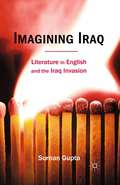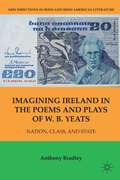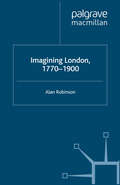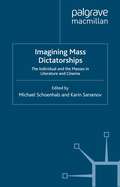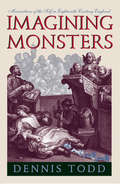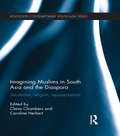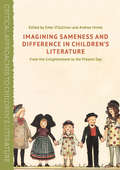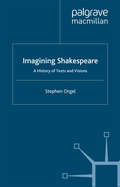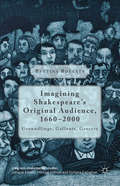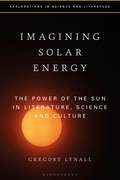- Table View
- List View
Imagining Inheritance from Chaucer to Shakespeare
by Alex DavisImpossible bequests of the soul; an outlawed younger son who rises to become justice of the king's forests; the artificially-preserved corpse of the heir to an empire; a medieval clerk kept awake at night by fears of falling; a seventeenth-century noblewoman who commissions copies upon copies of her genealogy; Elizabethan efforts to eradicate Irish customs of succession; thoughts of the legacy of sin bequeathed to mankind by our first parents, Adam and Eve. This book explores how inheritance was imagined between the lifetimes of Chaucer and Shakespeare. The writing composed during this period was the product of what the historian Georges Duby has called a 'society of heirs', in which inheritance functioned as a key instrument of social reproduction, acting to ensure that existing structures of status, wealth, familial power, political influence, and gender relations were projected from the present into the future. In poetry, prose, and drama—in Chaucer's Troilus and Criseyde and his Canterbury Tales; in Spenser's Faerie Queene; in plays by Shakespeare such as Macbeth, As You Like It, and The Merchant of Venice; and in a host of other works—we encounter a range of texts that attests to the extraordinary imaginative reach of questions of inheritance between the fourteenth and the seventeenth centuries. Moving between the late medieval and early modern periods, Imagining Inheritance examines this body of writing in order to argue that an exploration of the ways in which premodern inheritance was imagined can make legible the deep structures of power that modernity wants to forget.
Imagining Inheritance from Chaucer to Shakespeare
by Alex DavisImpossible bequests of the soul; an outlawed younger son who rises to become justice of the king's forests; the artificially-preserved corpse of the heir to an empire; a medieval clerk kept awake at night by fears of falling; a seventeenth-century noblewoman who commissions copies upon copies of her genealogy; Elizabethan efforts to eradicate Irish customs of succession; thoughts of the legacy of sin bequeathed to mankind by our first parents, Adam and Eve. This book explores how inheritance was imagined between the lifetimes of Chaucer and Shakespeare. The writing composed during this period was the product of what the historian Georges Duby has called a 'society of heirs', in which inheritance functioned as a key instrument of social reproduction, acting to ensure that existing structures of status, wealth, familial power, political influence, and gender relations were projected from the present into the future. In poetry, prose, and drama—in Chaucer's Troilus and Criseyde and his Canterbury Tales; in Spenser's Faerie Queene; in plays by Shakespeare such as Macbeth, As You Like It, and The Merchant of Venice; and in a host of other works—we encounter a range of texts that attests to the extraordinary imaginative reach of questions of inheritance between the fourteenth and the seventeenth centuries. Moving between the late medieval and early modern periods, Imagining Inheritance examines this body of writing in order to argue that an exploration of the ways in which premodern inheritance was imagined can make legible the deep structures of power that modernity wants to forget.
Imagining Iraq: Literature in English and the Iraq Invasion
by Suman GuptaIn the run-up to, during and after the invasion of Iraq a large number of literary texts addressing that context were produced, circulated and viewed as taking a position for or against the invasion, or contributing political insights. This book provides an in-depth survey of such texts to examine what they reveal about the condition of literature.
Imagining Ireland in the Poems and Plays of W. B. Yeats: Nation, Class, and State (New Directions in Irish and Irish American Literature)
by A. BradleyAn important part of the national imaginary, Yeat's work has helped to invent the nation of Ireland, while critiquing the modern state that emerged from it's revolutionary period. This study offers a chronological account of Yeat's volumes of poetry, contextualizing and analyzing them in light of Irish cultural and political history.
Imagining Irish Suburbia in Literature and Culture (New Directions in Irish and Irish American Literature)
by Eoghan Smith Simon WorkmanThis collection of critical essays explores the literary and visual cultures of modern Irish suburbia, and the historical, social and aesthetic contexts in which these cultures have emerged. The lived experience and the artistic representation of Irish suburbia have received relatively little scholarly consideration and this multidisciplinary volume redresses this critical deficit. It significantly advances the nascent socio-historical field of Irish suburban studies, while simultaneously disclosing and establishing a history of suburban Irish literary and visual culture. The essays also challenge conventional conceptions of what constitutes the proper domain of Irish writing and art and reveal that, though Irish suburban experience is often conceived of pejoratively by writers and artists, there are also many who register and valorise the imaginative possibilities of Irish suburbia and the meanings of its social and cultural life.
Imagining Ithaca: Nostos and Nostalgia Since the Great War
by Kathleen Riley'Though home is a name, a word, it is a strong one', said Charles Dickens, 'stronger than magician ever spoke, or spirit answered to, in strongest conjuration.' The ancient Greek word nostos, meaning homecoming or return, has a commensurate power and mystique. Irish philosopher-poet John Moriarty described it as 'a teeming word... a haunted word... a word to conjure with'. The most celebrated and culturally enduring nostos is that of Homer's Odysseus who spent ten years returning home after the fall of Troy. His journey back involved many obstacles, temptations, and fantastical adventures and even a katabasis, a rare descent by the living into the realm of the dead. All the while he was sustained and propelled by his memories of Ithaca ('His native home deep imag'd in his soul', as Pope's translation has it). From Virgil's Aeneid to James Joyce's Ulysses, from MGM's The Wizard of Oz to the Coen Brothers' O Brother, Where Art Thou?, and from Derek Walcott's Omeros to Margaret Atwood's Penelopiad, the Odyssean paradigm of nostos and nostalgia has been continually summoned and reimagined by writers and filmmakers. At the same time, 'Ithaca' has proved to be an evocative and versatile abstraction. It is as much about possibility as it is about the past; it is a vision of Arcadia or a haunting, an object of longing, a repository of memory, 'a sleep and a forgetting'. In essence it is about seeking what is absent. Imagining Ithaca explores the idea of nostos, and its attendant pain (algos), in an excitingly eclectic range of sources: from Rebecca West's The Return of the Soldier and Remarque's All Quiet on the Western Front, through the exilic memoirs of Nabokov and the time-travelling fantasies of Woody Allen, to Seamus Heaney's Virgilian descent into the London Underground and Michael Portillo's Telemachan railway journey to Salamanca. This kaleidoscopic exploration spans the end of the Great War, when the world at large was experiencing the complexities of homecoming, to the era of Brexit and COVID-19 which has put the notion of nostalgia firmly under the microscope.
Imagining Ithaca: Nostos and Nostalgia Since the Great War
by Kathleen Riley'Though home is a name, a word, it is a strong one', said Charles Dickens, 'stronger than magician ever spoke, or spirit answered to, in strongest conjuration.' The ancient Greek word nostos, meaning homecoming or return, has a commensurate power and mystique. Irish philosopher-poet John Moriarty described it as 'a teeming word... a haunted word... a word to conjure with'. The most celebrated and culturally enduring nostos is that of Homer's Odysseus who spent ten years returning home after the fall of Troy. His journey back involved many obstacles, temptations, and fantastical adventures and even a katabasis, a rare descent by the living into the realm of the dead. All the while he was sustained and propelled by his memories of Ithaca ('His native home deep imag'd in his soul', as Pope's translation has it). From Virgil's Aeneid to James Joyce's Ulysses, from MGM's The Wizard of Oz to the Coen Brothers' O Brother, Where Art Thou?, and from Derek Walcott's Omeros to Margaret Atwood's Penelopiad, the Odyssean paradigm of nostos and nostalgia has been continually summoned and reimagined by writers and filmmakers. At the same time, 'Ithaca' has proved to be an evocative and versatile abstraction. It is as much about possibility as it is about the past; it is a vision of Arcadia or a haunting, an object of longing, a repository of memory, 'a sleep and a forgetting'. In essence it is about seeking what is absent. Imagining Ithaca explores the idea of nostos, and its attendant pain (algos), in an excitingly eclectic range of sources: from Rebecca West's The Return of the Soldier and Remarque's All Quiet on the Western Front, through the exilic memoirs of Nabokov and the time-travelling fantasies of Woody Allen, to Seamus Heaney's Virgilian descent into the London Underground and Michael Portillo's Telemachan railway journey to Salamanca. This kaleidoscopic exploration spans the end of the Great War, when the world at large was experiencing the complexities of homecoming, to the era of Brexit and COVID-19 which has put the notion of nostalgia firmly under the microscope.
Imagining London, 1770-1900
by A. RobinsonCombining a unique overview of metropolitan visual culture with detailed textual analysis, this interdisciplinary study explores the relationship between the two cities which Londoners inhabited: the physical spaces of the metropolis, whose socially stratified and gendered topography was shaped by consumer culture and unregulated capitalism; and an imaginary 'London', an 'Unreal City' which reflected and influenced their understanding of, and actions in, the 'real' environment.
Imagining Mass Dictatorships: The Individual and the Masses in Literature and Cinema (Mass Dictatorship in the Twentieth Century)
by Michael Schoenhals and Karin SarsenovThis volume in the series Mass Dictatorship in the Twentieth Century series sees twelve Swedish, Korean and Japanese scholars, theorists, and historians of fiction and non-fiction probe the literary subject of life in 20th century mass dictatorships.
Imagining Methodism in Eighteenth-Century Britain: Enthusiasm, Belief, and the Borders of the Self
by Misty G. AndersonIn the eighteenth century, British Methodism was an object of both derision and desire. Many popular eighteenth-century works ridiculed Methodists, yet often the very same plays, novels, and prints that cast Methodists as primitive, irrational, or deluded also betrayed a thinly cloaked fascination with the experiences of divine presence attributed to the new evangelical movement. Misty G. Anderson argues that writers, actors, and artists used Methodism as a concept to interrogate the boundaries of the self and the fluid relationships between religion and literature, between reason and enthusiasm, and between theater and belief. Imagining Methodism situates works by Henry Fielding, John Cleland, Samuel Foote, William Hogarth, Horace Walpole, Tobias Smollett, and others alongside the contributions of John Wesley, Charles Wesley, and George Whitefield in order to understand how Methodism's brand of "experimental religion" was both born of the modern world and perceived as a threat to it.Anderson's analysis of reactions to Methodism exposes a complicated interlocking picture of the religious and the secular, terms less transparent than they seem in current critical usage. Her argument is not about the lives of eighteenth-century Methodists; rather, it is about Methodism as it was imagined in the work of eighteenth-century British writers and artists, where it served as a sign of sexual, cognitive, and social danger. By situating satiric images of Methodists in their popular contexts, she recaptures a vigorous cultural debate over the domains of religion and literature in the modern British imagination. Rich in cultural and literary analysis, Anderson's argument will be of interest to students and scholars of the eighteenth century, religious studies, theater, and the history of gender.
Imagining Methodism in Eighteenth-Century Britain: Enthusiasm, Belief, and the Borders of the Self
by Misty G. AndersonIn the eighteenth century, British Methodism was an object of both derision and desire. Many popular eighteenth-century works ridiculed Methodists, yet often the very same plays, novels, and prints that cast Methodists as primitive, irrational, or deluded also betrayed a thinly cloaked fascination with the experiences of divine presence attributed to the new evangelical movement. Misty G. Anderson argues that writers, actors, and artists used Methodism as a concept to interrogate the boundaries of the self and the fluid relationships between religion and literature, between reason and enthusiasm, and between theater and belief. Imagining Methodism situates works by Henry Fielding, John Cleland, Samuel Foote, William Hogarth, Horace Walpole, Tobias Smollett, and others alongside the contributions of John Wesley, Charles Wesley, and George Whitefield in order to understand how Methodism's brand of "experimental religion" was both born of the modern world and perceived as a threat to it.Anderson's analysis of reactions to Methodism exposes a complicated interlocking picture of the religious and the secular, terms less transparent than they seem in current critical usage. Her argument is not about the lives of eighteenth-century Methodists; rather, it is about Methodism as it was imagined in the work of eighteenth-century British writers and artists, where it served as a sign of sexual, cognitive, and social danger. By situating satiric images of Methodists in their popular contexts, she recaptures a vigorous cultural debate over the domains of religion and literature in the modern British imagination. Rich in cultural and literary analysis, Anderson's argument will be of interest to students and scholars of the eighteenth century, religious studies, theater, and the history of gender.
Imagining Monsters: Miscreations of the Self in Eighteenth-Century England
by Dennis ToddIn 1726, an illiterate woman from Surrey named Mary Toft announced that she had given birth to seventeen rabbits. Deceiving respected physicians and citizens alike, she created a hoax that held England spellbound for months. In Imagining Monsters, Dennis Todd tells the story of this bizarre incident and shows how it illuminates eighteenth-century beliefs about the power of imagination and the problems of personal identity. Mary Toft's outrageous claim was accepted because of a common belief that the imagination of a pregnant woman could deform her fetus, creating a monster within her. Drawing on largely unexamined material from medicine, embryology, philosophy, and popular "monster" exhibitions, Todd shows that such ideas about monstrous births expressed a fear central to scientific, literary, and philosophical thinking: that the imagination could transgress the barrier between mind and body. In his analysis of the Toft case, Todd exposes deep anxieties about the threat this transgressive imagination posed to the idea of the self as stable, coherent, and autonomous. Major works of Pope and Swift reveal that they, too, were concerned with these issues, and Imagining Monsters provides detailed discussions of Gulliver's Travels and The Dunciad illustrating how these writers used images of monstrosity to explore the problematic nature of human identity. It also includes a provocative analysis of Pope's later work that takes into account his physical deformity and his need to defend himself in a society that linked a deformed body with a deformed character.
Imagining Motherhood in Contemporary Irish and Caribbean Literature (New Caribbean Studies)
by Abigail L. PalkoImagining Motherhood in Contemporary Irish and Caribbean Literature undertakes a comparative transnational reading to develop more expansive literary models of good mothering. Abigail L. Palko argues that Irish and Caribbean literary representations of non-normative mothering practices do not reflect transgressive or dangerous mothering but are rather cultural negotiations of the definition of a good mother. This original book demonstrates the sustained commitment to countering the dominant ideologies of maternal self-sacrifice foundational to both Irish and Caribbean nationalist rhetoric, offering instead the possibility of integrating maternal agency into an effective model of female citizenship.
Imagining Muslims in South Asia and the Diaspora: Secularism, Religion, Representations (Routledge Contemporary South Asia Series)
by Claire Chambers Caroline HerbertLiterary, cinematic and media representations of the disputed category of the ‘South Asian Muslim’ have undergone substantial change in the last few decades and particularly since the events of September 11, 2001. Here we find the first book-length critical analysis of these representations of Muslims from South Asia and its diaspora in literature, the media, culture and cinema. Contributors contextualize these depictions against the burgeoning post-9/11 artistic interest in Islam, and also against cultural responses to earlier crises on the subcontinent such as Partition (1947), the 1971 Indo-Pakistan war and secession of Bangladesh, the 1992 Ayodhya riots , the 2002 Gujarat genocide and the Kashmir conflict. Offering a comparative approach, the book explores connections between artists’ generic experimentalism and their interpretations of life as Muslims in South Asia and its diaspora, exploring literary and popular fiction, memoir, poetry, news media, and film. The collection highlights the diversity of representations of Muslims and the range of approaches to questions of Muslim religious and cultural identity, as well as secular discourse. Essays by leading scholars in the field highlight the significant role that literature, film, and other cultural products such as music can play in opening up space for complex reflections on Muslim identities and cultures, and how such imaginative cultural forms can enable us to rethink secularism and religion. Surveying a broad range of up-to-date writing and cultural production, this concise and pioneering critical analysis of representations of South Asian Muslims will be of interest to students and academics of a variety of subjects including Asian Studies, Literary Studies, Media Studies, Women’s Studies, Contemporary Politics, Migration History, Film studies, and Cultural Studies.
Imagining Muslims in South Asia and the Diaspora: Secularism, Religion, Representations (Routledge Contemporary South Asia Series)
by Claire Chambers Caroline HerbertLiterary, cinematic and media representations of the disputed category of the ‘South Asian Muslim’ have undergone substantial change in the last few decades and particularly since the events of September 11, 2001. Here we find the first book-length critical analysis of these representations of Muslims from South Asia and its diaspora in literature, the media, culture and cinema. Contributors contextualize these depictions against the burgeoning post-9/11 artistic interest in Islam, and also against cultural responses to earlier crises on the subcontinent such as Partition (1947), the 1971 Indo-Pakistan war and secession of Bangladesh, the 1992 Ayodhya riots , the 2002 Gujarat genocide and the Kashmir conflict. Offering a comparative approach, the book explores connections between artists’ generic experimentalism and their interpretations of life as Muslims in South Asia and its diaspora, exploring literary and popular fiction, memoir, poetry, news media, and film. The collection highlights the diversity of representations of Muslims and the range of approaches to questions of Muslim religious and cultural identity, as well as secular discourse. Essays by leading scholars in the field highlight the significant role that literature, film, and other cultural products such as music can play in opening up space for complex reflections on Muslim identities and cultures, and how such imaginative cultural forms can enable us to rethink secularism and religion. Surveying a broad range of up-to-date writing and cultural production, this concise and pioneering critical analysis of representations of South Asian Muslims will be of interest to students and academics of a variety of subjects including Asian Studies, Literary Studies, Media Studies, Women’s Studies, Contemporary Politics, Migration History, Film studies, and Cultural Studies.
Imagining New York City: Literature, Urbanism, and the Visual Arts, 1890-1940
by Christoph LindnerUsing examples from architecture, film, literature, and the visual arts, this wide-ranging book examines the significance of New York City in the urban imaginary between 1890 and 1940. In particular, Imagining New York City considers how and why certain city spaces-such as the skyline, the sidewalk, the slum, and the subway-have come to emblematize key aspects of the modern urban condition. In so doing, Christoph Lindner also considers the ways in which cultural developments in the late nineteenth and early twentieth centuries set the stage for more recent responses to a variety of urban challenges facing the city, such as post-disaster recovery, the renewal of urban infrastructure, and the remaking of public space.
IMAGINING NEW YORK CITY C: Literature, Urbanism, and the Visual Arts, 1890-1940
by Christoph LindnerUsing examples from architecture, film, literature, and the visual arts, this wide-ranging book examines the significance of New York City in the urban imaginary between 1890 and 1940. In particular, Imagining New York City considers how and why certain city spaces-such as the skyline, the sidewalk, the slum, and the subway-have come to emblematize key aspects of the modern urban condition. In so doing, Christoph Lindner also considers the ways in which cultural developments in the late nineteenth and early twentieth centuries set the stage for more recent responses to a variety of urban challenges facing the city, such as post-disaster recovery, the renewal of urban infrastructure, and the remaking of public space.
Imagining Otherwise: How Readers Help to Write Nineteenth-Century Novels
by Debra GettelmanHow Victorian authors engaged the imaginations of their readers and elevated the novel to new heightsAs novel publication exploded in nineteenth-century Britain, writers such as Jane Austen, Charles Dickens, and George Eliot learned from experience—sometimes grudgingly—that readers tend to make their own imaginative contributions to fictional worlds. Imagining Otherwise shows how Victorian writers acknowledged, grappled with, and ultimately enlisted the prerogative of readers to conjure alternatives and add depth to the words on the page.Debra Gettelman provides incisive new readings of novels such as Sense and Sensibility, Little Dorrit, and Middlemarch, exploring how novelists known for prescriptive and didactic narrative voices were at the same time exploring the aesthetic potential for the reader&’s independent imagination to lend nuance and authenticity to fiction. Modernist authors of the twentieth century have long been considered pioneers in cultivating the reader&’s capacity to imagine what is not said as part of the art of fiction. Gettelman uncovers the roots of this tradition of novel reading a century earlier and challenges literary criticism that dismisses this spontaneous, readerly impulse as being unworthy of serious examination.As readers demand novels with relatable characters and fan fiction grows in popularity, the reader&’s imagination has become a determining element of today&’s literary environment. Imagining Otherwise takes a deeper look at this history, offering a critical perspective on how we came to view fiction as a site of imaginative appropriation.
Imagining Outer Space: European Astroculture in the Twentieth Century (Palgrave Studies in the History of Science and Technology)
by Alexander C.T. GeppertImagining Outer Space makes a captivating advance into the cultural history of outer space and extraterrestrial life in the European imagination. How was outer space conceived and communicated? What promises of interplanetary expansion and cosmic colonization propelled the project of human spaceflight to the forefront of twentieth-century modernity? In what way has West-European astroculture been affected by the continuous exploration of outer space? Tracing the thriving interest in spatiality to early attempts at exploring imaginary worlds beyond our own, the book analyzes contact points between science and fiction from a transdisciplinary perspective and examines sites and situations where utopian images and futuristic technologies contributed to the omnipresence of fantasmatic thought. Bringing together state-of-the-art work in this emerging field of historical research, the volume breaks new ground in the historicization of the Space Age.
Imagining Sameness and Difference in Children's Literature: From the Enlightenment to the Present Day (Critical Approaches to Children's Literature)
by Andrea Immel Emer O'SullivanThis book investigates how cultural sameness and difference has been presented in a variety of forms and genres of children’s literature from Denmark, Germany, France, Russia, Britain, and the United States; ranging from English caricatures of the 1780s to dynamic representations of contemporary cosmopolitan childhood. The chapters address different models of presenting foreigners using examples from children’s educational prints, dramatic performances, travel narratives, comics, and picture books. Contributors illuminate the ways in which the texts negotiate the tensions between the Enlightenment ideal of internationalism and discrete national or ethnic identities cultivated since the Romantic era, providing examples of ethnocentric cultural perspectives and of cultural relativism, as well as instances where discussions of child reader agency indicate how they might participate eventually in a tolerant transnational community.
Imagining Shakespeare: A History of Texts and Visions
by Stephen OrgelIn this beautifully illustrated book, one of the foremost Shakespeareans of our time explores the ways in which Shakespeare has been imagined from his time to ours. Drawing on performance history, textual history and the visual arts (including a fascinating chapter on portraiture), Imagining Shakespeare displays throughout the cultural versatility, elegance, lucidity and wit which have become the hallmarks of Stephen Orgel's style.
Imagining Shakespeare's Original Audience, 1660-2000: Groundlings, Gallants, Grocers (Palgrave Shakespeare Studies)
by Bettina BoeckerComparatively little is known about Shakespeare's first audiences. This study argues that the Elizabethan audience is an essential part of Shakespeare as a site of cultural meaning, and that the way criticism thinks of early modern theatregoers is directly related to the way it thinks of, and uses, the Bard himself.
Imagining Socialism: Aesthetics, Anti-politics, and Literature in Britain, 1817-1918
by Mark A. Allison"Socialism" names a form of collective life that has never been fully realized; consequently, it is best understood as a goal to be imagined. So this study argues, and thereby uncovers an aesthetic impulse that animates some of the most consequential socialist writing, thought, and practice of the long nineteenth century. Imagining Socialism explores this tradition of radical activism, investigating the diverse ways that British socialists—from Robert Owen to the mid-century Christian Socialists to William Morris—marshalled the resources of the aesthetic in their efforts to surmount "politics" and develop non-governmental forms of collective life. Their ambitious attempts at social regeneration led some socialists to explore the liberatory possibilities afforded by cooperative labor, women's emancipation, political violence, and the power of the arts themselves. Imagining Socialism demonstrates that, far from being confined to the "socialist revival" of the fin de siècle, important socialist experiments with the emancipatory potential of the aesthetic in Britain may be found throughout the period it calls the "socialist century"—and may still inspire us today.
Imagining Socialism: Aesthetics, Anti-politics, and Literature in Britain, 1817-1918
by Mark A. Allison"Socialism" names a form of collective life that has never been fully realized; consequently, it is best understood as a goal to be imagined. So this study argues, and thereby uncovers an aesthetic impulse that animates some of the most consequential socialist writing, thought, and practice of the long nineteenth century. Imagining Socialism explores this tradition of radical activism, investigating the diverse ways that British socialists—from Robert Owen to the mid-century Christian Socialists to William Morris—marshalled the resources of the aesthetic in their efforts to surmount "politics" and develop non-governmental forms of collective life. Their ambitious attempts at social regeneration led some socialists to explore the liberatory possibilities afforded by cooperative labor, women's emancipation, political violence, and the power of the arts themselves. Imagining Socialism demonstrates that, far from being confined to the "socialist revival" of the fin de siècle, important socialist experiments with the emancipatory potential of the aesthetic in Britain may be found throughout the period it calls the "socialist century"—and may still inspire us today.
Imagining Solar Energy: The Power of the Sun in Literature, Science and Culture (Explorations in Science and Literature)
by Gregory LynallHow has humanity sought to harness the power of the Sun, and what roles have literature, art and other cultural forms played in imagining, mythologizing and reflecting the possibilities of solar energy? What stories have been told about solar technologies, and how have these narratives shaped developments in science and culture? What can solar power's history tell us about its future, within a world adapting to climate crisis? Identifying the history of capturing solar radiance as a focal point between science and the imagination, Imagining Solar Energy argues that the literary, artistic and mythical resonances of solar power – from the Renaissance to the present day – have not only been inspired by, but have also cultivated and sustained its scientific and technological development. Ranging from Archimedes to Isaac Asimov, John Dee to Humphry Davy, Aphra Behn to J. G. Ballard, the book argues that solar energy translates into many different kinds of power (physical, political, intellectual and cultural), and establishes for the first time the importance of solar energy to many literary and scientific endeavours.

